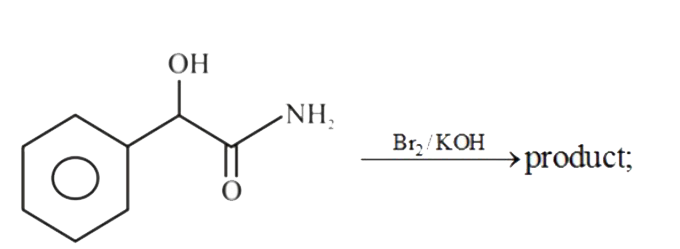Write short notes on the following:
(i) Carbylamine reaction
(ii) Gabriel phthalimide reaction.
(iii) Hoffmann bromamide reaction.
(iv) Gattermann reaction.
(v) Balz Schiemann reaction.
(vi) Coupling reaction.
Step-by-Step Text Solution
(i) Carbylamine Reaction
The Carbylamine reaction is a chemical reaction used primarily for the detection of primary amines. In this reaction, a primary amine reacts with chloroform (CHCl3) in the presence of an alcoholic solution of potassium hydroxide (KOH). The general reaction can be summarized as follows:
RNH2+CHCl3+3KOH→RNC+3KCl+3H2O
Where R represents an alkyl or aryl group. The product formed is an isocyanide (or carbylamine), which is characterized by its foul odor, making this reaction useful for the identification of primary amines.
(ii) Gabriel Phthalimide Reaction
The Gabriel Phthalimide reaction is a method for synthesizing primary amines from alkyl halides. The reaction involves the use of phthalimide, which is treated with a strong base (like KOH) to form a phthalimide anion. This anion then acts as a nucleophile and reacts with an alkyl halide (R-X) to form an N-alkyl phthalimide. The subsequent hydrolysis of this compound yields the desired primary amine (R-NH2) and phthalic acid as a byproduct.
The reaction can be summarized as follows:
1. Formation of phthalimide anion:
Phthalimide+KOH→Phthalimide anion+H2O
2. Alkylation:
Phthalimide anion+R-X→N-alkyl phthalimide
3. Hydrolysis:
N-alkyl phthalimide+NaOH (aq)→R-NH2+Phthalic acid
(iii) Hofmann Bromamide Reaction
The Hofmann bromamide reaction involves the conversion of primary amides to primary amines through a series of steps. The reaction typically uses bromine (Br2) and a strong base (like NaOH). The amide undergoes degradation to yield the corresponding primary amine.
The general reaction can be represented as follows:
RCO-NH2+Br2+4NaOH→RNH2+Na2CO3+2NaBr+2H2O
Where RCO-NH2 is the primary amide, and RNH2 is the primary amine produced.
(iv) Gattermann Reaction
The Gattermann reaction is used to synthesize chlorobenzene or bromobenzene from benzene diazonium chloride. In this reaction, benzene diazonium chloride is treated with copper(I) chloride (CuCl) or copper(I) bromide (CuBr) in the presence of hydrochloric acid (HCl) or hydrobromic acid (HBr), respectively.
The reaction can be summarized as follows:
1. For chlorobenzene:
C6H5N+2Cl−+CuCl→C6H5Cl+N2+CuCl
2. For bromobenzene:
C6H5N+2Br−+CuBr→C6H5Br+N2+CuBr
(v) Balz-Schiemann Reaction
The Balz-Schiemann reaction is a method for converting aniline (phenylamine) into fluorobenzene. In this reaction, aniline is treated with tetrafluoroborate (BF4) in the presence of a photochemical condition (UV light) to form a diazonium salt. Upon heating, the diazonium salt decomposes to yield fluorobenzene and nitrogen gas.
The reaction can be summarized as follows:
1. Formation of diazonium salt:
C6H5NH2+BF4→C6H5N+2BF−4
2. Decomposition under photochemical conditions:
C6H5N+2BF−4hν−→C6H5F+N2+BF3
(vi) Coupling Reaction
The coupling reaction involves the reaction of diazonium salts with phenols or aromatic compounds to form azo compounds. In this reaction, benzene diazonium chloride reacts with phenol, where the hydrogen atom at the para position is replaced by the diazonium group, resulting in the formation of para-hydroxybenzene (also known as p-phenol).
The reaction can be summarized as follows:
C6H5N+2+C6H5OH→C6H4(OH)(N+2)+HCl
The Carbylamine reaction is a chemical reaction used primarily for the detection of primary amines. In this reaction, a primary amine reacts with chloroform (CHCl3) in the presence of an alcoholic solution of potassium hydroxide (KOH). The general reaction can be summarized as follows:
The Gabriel Phthalimide reaction is a method for synthesizing primary amines from alkyl halides. The reaction involves the use of phthalimide, which is treated with a strong base (like KOH) to form a phthalimide anion. This anion then acts as a nucleophile and reacts with an alkyl halide (R-X) to form an N-alkyl phthalimide. The subsequent hydrolysis of this compound yields the desired primary amine (R-NH2) and phthalic acid as a byproduct.
Phthalimide+KOH→Phthalimide anion+H2O
2. Alkylation:
Phthalimide anion+R-X→N-alkyl phthalimide
N-alkyl phthalimide+NaOH (aq)→R-NH2+Phthalic acid
The Hofmann bromamide reaction involves the conversion of primary amides to primary amines through a series of steps. The reaction typically uses bromine (Br2) and a strong base (like NaOH). The amide undergoes degradation to yield the corresponding primary amine.
The Gattermann reaction is used to synthesize chlorobenzene or bromobenzene from benzene diazonium chloride. In this reaction, benzene diazonium chloride is treated with copper(I) chloride (CuCl) or copper(I) bromide (CuBr) in the presence of hydrochloric acid (HCl) or hydrobromic acid (HBr), respectively.
C6H5N+2Cl−+CuCl→C6H5Cl+N2+CuCl
C6H5N+2Br−+CuBr→C6H5Br+N2+CuBr
The Balz-Schiemann reaction is a method for converting aniline (phenylamine) into fluorobenzene. In this reaction, aniline is treated with tetrafluoroborate (BF4) in the presence of a photochemical condition (UV light) to form a diazonium salt. Upon heating, the diazonium salt decomposes to yield fluorobenzene and nitrogen gas.
C6H5NH2+BF4→C6H5N+2BF−4
C6H5N+2BF−4hν−→C6H5F+N2+BF3
The coupling reaction involves the reaction of diazonium salts with phenols or aromatic compounds to form azo compounds. In this reaction, benzene diazonium chloride reacts with phenol, where the hydrogen atom at the para position is replaced by the diazonium group, resulting in the formation of para-hydroxybenzene (also known as p-phenol).
Topper's Solved these Questions
- ORGANIC COMPOUNDS CONTAINING NITROGEN BOOK - MODERN PUBLICATIONCHAPTER - ORGANIC COMPOUNDS CONTAINING NITROGEN EXERCISE - REVISION EXERCISES LONG ANSWER QUESTIONS
5 Videos
- ORGANIC COMPOUNDS CONTAINING NITROGEN BOOK - MODERN PUBLICATIONCHAPTER - ORGANIC COMPOUNDS CONTAINING NITROGEN EXERCISE - HIGHER ORDER THINKING SKILLS (ADVANCED LEVEL)
13 Videos
- ORGANIC COMPOUNDS CONTAINING NITROGEN BOOK - MODERN PUBLICATIONCHAPTER - ORGANIC COMPOUNDS CONTAINING NITROGEN EXERCISE - REVISION EXERCISES VERY SHORT ANSWER QUESTIONS
31 Videos
- HALOALKANES AND HALOARENESBOOK - MODERN PUBLICATIONCHAPTER - HALOALKANES AND HALOARENESEXERCISE - UNIT PRACTICE TEST
11 Videos
- POLYMERSBOOK - MODERN PUBLICATIONCHAPTER - POLYMERSEXERCISE - Competition file (OBJECTIVE TYPE QUESTIONS) (C. MULTIPLE CHOICE QUESTIONS)(Integer Type Questions)
6 Videos
Similar Questions
Knowledge Check

Product of this Hoffmann bromamide reaction is :APh−O∣∣C−CH3BPh - CHOC DPh−CH2−NH2
DPh−CH2−NH2
Write Gattermann's reaction.
View SolutionWrite carbylamine reaction .
View SolutionWrite short note on the following :
(i) Carbylamine reaction
(ii) Diazotization
(iii) Hoffmann's bromide reaction
(iv) Coupling reaction
(v) Ammonolysis
View SolutionWrite short on the following :
(i) Carbylamine reaction
(ii) Hofmann's bromamide reaction
(iii) Gabriel phthalimide synthesis.
View SolutionWhat is Balz-Schiemann reaction?
View Solution
Product of this Hoffmann bromamide reaction is
View SolutionWrite a note on coupling reaction.
View Solution
